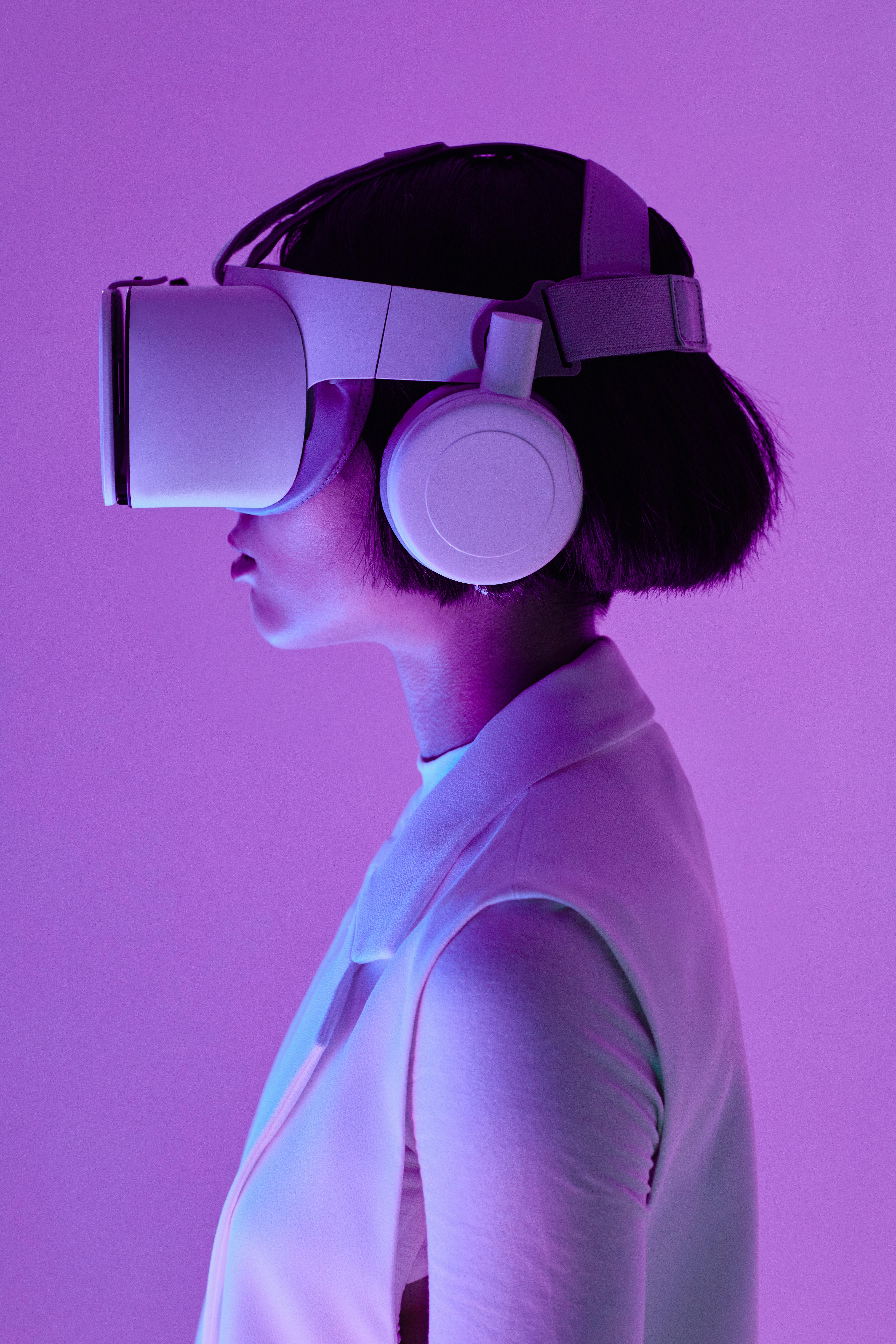What is Virtual Reality (VR)?
Virtual Reality (VR) is an immersive technology that transports you into a simulated environment, allowing you to experience a different reality without actually being there physically. Through the use of specialized VR devices like headsets and motion controllers, you can interact with and explore computer-generated environments in a realistic way.
Definition of Virtual Reality
Virtual Reality creates a computer-generated environment that simulates a real or imagined world. It aims to provide a multisensory experience by stimulating your vision, hearing, and sometimes even touch. By wearing a VR headset, you are visually immersed in a virtual world that feels like a new reality.
How Virtual Reality Works
VR works by tracking your head movements and adjusting the visuals accordingly. This creates the illusion of being present in a virtual environment. The headset may also have built-in sensors to track your hand movements and gestures. Additionally, VR applications may incorporate spatial audio to enhance the immersive experience further.
Applications of Virtual Reality
Virtual Reality has applications in various fields, such as gaming, entertainment, education, and healthcare. In gaming, VR can transport you to a fantasy world where you can interact with characters and objects. In education, VR can provide realistic simulations for training purposes. Healthcare professionals can use VR to practice medical procedures or help patients overcome fears and phobias through exposure therapy. The possibilities for VR are vast and continually expanding.

This image is property of images.pexels.com.
## Types of Virtual Reality
Virtual Reality (VR) is an exciting technology that allows you to step into a completely immersive digital world, while Augmented Reality (AR) enriches your real-world experience by overlaying digital elements. In this section, we will explore the different types of VR that exist, each offering unique experiences.
Fully Immersive VR
Fully Immersive VR provides the most intense and realistic virtual experiences. With the help of a head-mounted display (HMD), you are transported to a virtual world that completely replaces your surroundings. This type of VR typically requires additional accessories like handheld controllers and motion sensors to interact with the virtual environment.
Non-immersive VR
Non-immersive VR offers a less intense, but still engaging, virtual experience. Instead of completely replacing your environment, this type of VR allows you to view and interact with virtual content on a screen, such as a computer monitor or smartphone. You can explore digital worlds, play games, and watch videos, without being fully immersed in a virtual environment.
Semi-Immersive VR
Semi-Immersive VR combines elements of both immersive and non-immersive VR. It involves using a head-mounted display to view virtual content while still being aware of your real-world surroundings. This type of VR is commonly used in training simulations and educational experiences, where users need to interact with virtual objects while maintaining some awareness of their physical environment.
By understanding the different types of VR, you can choose the level of immersion that suits your preferences and goals. Whether you want to fully dive into a virtual world or enhance your real-world experience with digital elements, VR and AR have something exciting to offer for beginners like you.

This image is property of images.pexels.com.
## What is Augmented Reality (AR)?
Definition of Augmented Reality
Augmented Reality (AR) is a cutting-edge technology that allows you to experience a digitally enhanced version of the real world. Unlike Virtual Reality (VR), which transports you to a completely simulated environment, AR overlays digital information onto the physical world, merging the virtual with the real. By using devices such as smartphones, tablets, or specialized AR glasses, you can interact with virtual elements, graphics, or even holograms in real-time.
How Augmented Reality Works
AR technology utilizes a combination of cameras, sensors, and advanced algorithms to track and analyze the user’s surroundings. By leveraging these technologies, AR applications identify key features and objects in the environment and then superimpose digital content onto them. As you move or change your perspective, the AR system continuously updates the virtual elements, ensuring an immersive and interactive experience.
Applications of Augmented Reality
Augmented Reality has a wide range of applications across various industries. In gaming, AR brings virtual characters and scenarios into your surroundings, creating a truly immersive gaming experience. in education, AR allows for interactive learning through visual and auditory displays, enhancing student engagement. Moreover, AR is increasingly used in healthcare, architecture, retail, and even tourism. In these fields, AR provides valuable information, improves customer experiences, and assists professionals in their work.
In short, Augmented Reality blends the real and virtual worlds, enabling new possibilities for entertainment, education, and more.

This image is property of images.pexels.com.
## Key Differences Between VR and AR
Virtual Reality (VR) and Augmented Reality (AR) are two closely related but distinct technologies that are revolutionizing the way we interact with the digital world. Understanding the key differences between VR and AR is essential for beginners to grasp their unique characteristics and potential applications.
Immersion Level
One of the main differences between VR and AR lies in the level of immersion they provide. In VR, users are fully immersed in a simulated environment, shutting out the real world entirely. With the help of specialized headsets, users can explore and interact with virtual worlds in a highly immersive manner. On the other hand, AR overlays digital content onto the real world, allowing users to see and interact with virtual objects alongside the physical environment. AR does not block out the real world, maintaining a level of interaction with the immediate surroundings.
Interaction with the Real World
Another key difference is the interaction with the real world. In VR, users are completely disconnected from their physical surroundings, as they are fully engrossed in the virtual environment. In contrast, AR seamlessly integrates digital content with the real world, providing an enhanced and interactive experience. AR technology is designed to supplement and enhance the real world, allowing users to interact with virtual objects while still being aware of their physical surroundings.
Use Cases and Applications
Both VR and AR have a wide range of use cases and applications. VR is often used in gaming, simulations, training environments, and entertainment experiences that require complete immersion. AR, on the other hand, has found applications in various fields such as education, healthcare, architecture, and marketing. AR can be used for training purposes, visualizing complex data, real-time collaboration, and enhancing user experiences in various industries.
Understanding the key differences between VR and AR is crucial for beginners to determine which technology best suits their needs. Whether it’s the fully immersive experience of VR or the augmented integration of AR, both technologies offer unique and exciting possibilities for a variety of industries and purposes. By exploring VR and AR further, you can uncover endless opportunities to enhance your digital experience and connect with a world beyond the limits of the physical realm.
History of Virtual and Augmented Reality
Virtual Reality (VR) and Augmented Reality (AR) have rapidly evolved over the years, revolutionizing the way we interact with digital content. Understanding the history of VR and AR can provide valuable insights into their development and the possibilities they present.
Early Development of VR and AR
VR has its roots dating back to the late 1960s when researchers sought to create immersive experiences. The Sensorama, invented by Morton Heilig in 1962, marked an early milestone in VR technology. However, it wasn’t until 1987 when the term “Virtual Reality” was coined by Jaron Lanier, a computer scientist.
AR, on the other hand, gained recognition in the early 1990s with the introduction of the Virtual Fixtures system by Thomas Caudell at Boeing. This technology allowed workers to visualize and manipulate virtual objects while performing tasks.
Advancements in Recent Years
In recent years, VR and AR have witnessed significant advancements, driven by technological breakthroughs. With the popularity of smartphones, VR headsets and AR applications have become more accessible to the general public. Companies like Oculus and HTC have introduced affordable VR headsets, while smartphone AR apps like Pokemon Go have gained widespread popularity.
The progress made in VR and AR has also extended to various industries, including healthcare, education, and entertainment. Medical professionals are using VR for surgical simulations and therapy treatments. Educators are utilizing AR to create interactive and immersive learning experiences. Additionally, the gaming industry has embraced VR and AR, offering gamers new levels of immersion.
The history of VR and AR spans several decades, with significant development and advancement in recent years. As technology continues to evolve, the potential of VR and AR is limitless, providing endless possibilities for users across various fields and industries.
Hardware for VR and AR
Virtual Reality (VR) and Augmented Reality (AR) are immersive technologies that offer users the opportunity to experience simulated environments and interact with virtual objects in a realistic way. To fully enjoy these experiences, you will need the right hardware.
Headsets and Displays
The cornerstone of VR and AR is the headset. These devices are worn over your eyes and use screens to display virtual content. They come in various types, from high-end devices like Oculus Rift and HTC Vive to more affordable options like Google Cardboard. Choosing a headset depends on your budget and level of immersion you desire.
Motion Tracking Systems
To make your movements in the real world translate into the virtual environment, motion tracking systems are essential. These systems use sensors to track the position and movements of your body. High-end headsets usually come with built-in sensors, while more budget-friendly options may require external sensors like cameras or motion controllers.
Input Devices
Interacting with virtual objects requires input devices. These can range from basic controllers with buttons or joysticks to advanced options like gloves or hand tracking devices. The choice of input device depends on the type of interaction you prefer and the level of realism you want to achieve.
Having the right hardware is crucial for a satisfying VR or AR experience. Invest in quality headsets, motion tracking systems, and input devices that fit your needs and budget.
Software for VR and AR
Development Platforms
When it comes to exploring the world of virtual and augmented reality, it’s essential to have the right software tools at your disposal. In this section, we will dive into the different types of software that are commonly used in VR and AR development.
Firstly, development platforms are essential for creating immersive experiences. These platforms provide developers with the necessary tools and frameworks to build stunning VR and AR applications. Some popular development platforms include Unity, Unreal Engine, and Oculus SDK. These platforms enable you to bring your virtual and augmented reality ideas to life by providing powerful rendering capabilities and intuitive interface design.
Content Creation Tools
To truly harness the potential of VR and AR, content creation tools play a crucial role. These tools allow you to design and build the virtual environments and augmented reality experiences. Programs like Blender, SketchUp, and Tilt Brush enable you to create 3D models and assets, while tools like Vuforia and ARKit help in the creation of marker-based augmented reality experiences. These content creation tools empower you to unleash your creativity and build immersive worlds for others to explore.
Applications and Games
Finally, applications and games are the end products that users interact within virtual and augmented reality. From educational experiences that transport you to historical events to thrilling games that immerse you in action-packed adventures, the possibilities are endless. Whether you prefer exploring a virtual museum or battling alien creatures, the world of VR and AR applications and games offer a wide range of experiences to cater to all interests.
In this section, we have discussed the different software aspects of VR and AR, including development platforms, content creation tools, and the end products – applications and games. This knowledge will allow you to dive deeper into the field of virtual and augmented reality and unleash your creativity with the right tools at your disposal.
Current Industry Landscape of VR and AR
Major Players in the VR and AR Market
The world of virtual reality (VR) and augmented reality (AR) is rapidly evolving, with major players shaping the industry. Companies like Oculus, HTC Vive, and Playstation VR dominate the VR market, offering high-quality headsets and immersive experiences. On the other hand, AR is dominated by tech giants such as Microsoft with their HoloLens and Magic Leap with their Magic Leap One. These companies are continuously pushing the boundaries of VR and AR technology, unleashing new possibilities and experiences for users. Their innovative hardware and software advancements have paved the way for exciting developments in various sectors, including gaming, healthcare, education, and entertainment.
Industry Challenges and Opportunities
While VR and AR have gained considerable traction, there are still challenges to overcome. The high cost of VR and AR hardware, limited content availability, and the need for significant processing power are some barriers that may hinder wider adoption. However, the potential opportunities are immense. VR and AR have the potential to revolutionize industries by providing immersive training simulations, enhancing the way we interact with digital information, and creating new forms of entertainment. As technology advances and becomes more affordable, the industry is poised for substantial growth and innovation. The future of VR and AR holds endless possibilities, and by exploring these technologies, you can take part in shaping the exciting landscape.
Potential Impact and Future of VR and AR
Virtual Reality (VR) and Augmented Reality (AR) are rapidly evolving technologies that have the potential to revolutionize various industries and change the way we experience the world. This section will explore the potential impact and future of VR and AR.
Implications in Various Industries
VR and AR have already started making waves in industries such as gaming, entertainment, education, healthcare, and retail. In gaming, VR allows players to immerse themselves in a virtual environment, providing a more engaging and realistic experience. In education, AR can enhance learning by overlaying digital information onto the real world, making complex concepts easier to understand. In healthcare, VR can be used for pain management and therapy sessions. The retail industry can benefit from AR by offering customers virtual try-on experiences and interactive product demonstrations.
Technological Advancements and Innovations
As technology continues to advance, VR and AR experiences will become more sophisticated and accessible. Innovations such as improved hardware, wireless capabilities, and higher resolution displays are paving the way for more realistic and immersive experiences. Additionally, the development of haptic feedback technology will further enhance the sense of touch in VR environments.
Predictions for the Future
Experts predict that VR and AR will continue to grow and become even more integrated into our daily lives. In the future, we can expect to see VR and AR being used in fields like architecture and design, manufacturing, tourism, and even remote collaboration. As these technologies become more affordable and user-friendly, they will become accessible to a wider audience, allowing for greater innovation and creativity.
VR and AR have the potential to significantly impact various industries and shape the way we interact with the world. As technology continues to advance, we can look forward to a future where VR and AR are seamlessly integrated into our lives, providing us with unique and immersive experiences.
Conclusion
Summary of VR and AR Concepts
In this article, you have been introduced to the exciting world of virtual reality (VR) and augmented reality (AR). VR is a computer-generated simulation that immerses you in a completely virtual environment, while AR overlays digital information onto the real world. You have learned that VR headsets like the Oculus Rift and HTC Vive can transport you to immersive experiences, giving you the sense of actually being present in a different world. On the other hand, AR can enhance your current environment by adding virtual objects or information through devices like the Microsoft HoloLens or smartphone apps like Pokemon Go.
Importance of Exploring Virtual and Augmented Reality
Exploring virtual and augmented reality is crucial as these technologies have the potential to revolutionize various industries such as gaming, education, healthcare, and entertainment. By embracing VR and AR, you can gain a deeper understanding of their capabilities and use them to your advantage. These technologies offer opportunities for enhanced learning experiences, improved productivity, and innovative entertainment options. Understanding the concepts behind VR and AR will help you make informed decisions when it comes to purchasing devices, creating content, or choosing to incorporate these technologies into your daily life. So, take the first step and dive into the exciting world of VR and AR!
